Lathe
![]()
The title of this article is ambiguous. For treatment devices in psychiatry, see lathe (psychiatry).
A lathe is a machine tool intended primarily for the turning manufacturing process and is used to produce rotationally symmetrical workpieces (turned parts). All lathes can also be used for drilling, provided that the centre of the hole coincides with the axis of rotation. Some lathes also have additional equipment for milling or slotting.
A wide variety of bodies of revolution can be produced on the lathe; in the simplest case, these are cylindrical turned parts that can also have flat surfaces perpendicular to the axis of rotation. More complex shapes are conical or spherical surfaces or free forms, which can also deviate from the rotational symmetry by means of additional devices. The workpiece performs the cutting movement by rotation. The tool, the turning tool, is firmly clamped on the tool slide, carries out the feed movement with it and continuously removes a chip by moving the slide longitudinally or also transversely to the axis of rotation of the workpiece along the surface to be machined. There are also special designs in which the workpiece is fixed to the machine table and remains stationary while the tool rotates (around it for external turning, inside it for internal turning). Lathes come in numerous different designs and with every possible degree of automation. The main components are the frame with the guides for the slides and the tailstock, the slides, the drive and the control.
The predecessor of today's lathes is the lathe, which usually has no machine drive and never more than a tool slide. The change from lathe to lathe occurred at the turn of the 18th century with the introduction of the tool slide, the use of a draw and lead screw to create the kinematics between rotation of the workpiece and feed of the tool, and the all-metal lathe. With the lead screw, the tool was positively guided, and the quality of the turned parts no longer depended so much on the skill of the lathe operator. Lathes made a decisive contribution to the industrial revolution, because many machine components, for example for steam, spinning and weaving machines, could only be produced economically in significant quantities by turning. Typical components produced by turning are axles, shafts, screws, spindles or bolts.
The term lathe only became common in linguistic usage from about 1950 onwards. It has now become fully established in technical literature, but many specialists still prefer the term lathe orally. In so-called CNC lathes, the machining processes are defined in computer programs; subsequent machining is automatic, with tool movements controlled electronically.
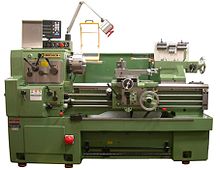
One center lathe and one center spindle lathe
History
See also: History of Production Engineering, Machining#History and Turning (Process)#History
The origin of the lathe can no longer be dated precisely today, but it represents a reversal of the kinematics of drilling. The earliest finds, which due to their shape suggest turning work, can be dated to the end of the 2nd millennium BC and come from the Mycenaean region. However, the woods found are so weathered that the grooves typical of woodturning are no longer recognizable and thus the final proof is missing. The first pieces of work that were definitely identified as woodturning were discovered in a tomb near Corneto, the so-called Tomba del Guerriero (Warrior's Tomb), which can be dated to the early 6th century BC. The first depiction describing the principle of the lathe was found in an Egyptian tomb, the Tomb of Petosiris, dating from 300 B.C. Using a string, one man drove the workpiece while the other held the tool against it. According to Greek mythology, Daidalos invented the corded lathe.
From the 8th century A.D. a drawing survives showing the generation of rotary motion by means of a fiddle-bow drive; the rotary part is rotated by a string stretched in a bow by reciprocating motion. The 13th century saw the advent of the luffing or seesaw lathe, in which the string was attached at one end to a footboard and at the other to a spring, usually in the form of a batten fixed to the ceiling. With this design the lathe operator could drive the apparatus with his foot and have both hands free to guide the tool. The English name for lathe, lathe, comes from the batten used as a spring.
At the beginning of the 15th century, the hand crank was used as a drive. Leonardo da Vinci also invented a lathe in which a flywheel was driven by a footboard, thus enabling a continuous rotary motion. However, this concept did not catch on. The first drawing of a lathe with support dates from 1480. The drawing describes a lathe with a wooden tool slide to feed the turning tool and a turning part that could be moved in the longitudinal direction. Leonardo da Vinci also used a tool holder as early as 1490.
In 1571, Jacques Besson designed a lathe with automatic mechanical feed via the lead screw. Two weights pulled the tool slide upwards via pulleys and thus pressed the tool against the workpiece. In precision mechanics, lathes after 1650 were already largely made of metal and from 1750 onwards already had all the essential features of a modern lathe, such as a leading spindle, change gears and a cross support. Even a drawing of a copy lathe from 1741 is known. These early achievements were only possible because of their small size. The first support lathe suitable for mechanical engineering was probably made by the American Sylvain Brown in 1791. Seven years later, David Wilkinson, also an American, patented a support lathe.
Henry Maudslay, one of the founding fathers of machine tool manufacturing, finally succeeded in producing a lead screw lathe for mechanical engineering made entirely of metal. It had a cross support as well as a feed dependent on the revolution, which allowed the production of identical, interchangeable parts. This method, known as interchangeable construction, was particularly suitable for screws, because before Maudslay's invention all threads were individual and not interchangeable. Shortly afterwards, the cross slide was designed and also coupled to the lead screw. Maudslay, in turn, now also used change gears for the feed in order to be able to turn threads with different pitches with one and the same lead screw. The first lead screw lathe in Germany came from London in 1810 and was purchased by the Koenig & Bauer machine factory in Würzburg. The first vertical lathe was manufactured in 1839 by the Swiss engineer Johann Georg Bodmer during his time at Whitworth in England.
In 1840, Joseph Whitworth expanded the well-known lathe with additional available tools and slides (multi-steel and multi-slide lathe). These were able to machine the workpieces with several tools simultaneously, thus shortening the very long machining times at the time. In 1852, the crank pin lathe from the USA attempted to produce the cutting motion with a revolving tool, but this process never gained sufficient acceptance. In 1852-1860, the American Stephen Fitch designed the top slide as a turret and thus invented the turret lathe. Just one year later, in 1861, the lathe was extended to include further work spindles. The first automatic lathe was patented by Ch. M. Spencer in 1873. The leading and traction spindle lathe was developed in 1880 and was able to perform almost all turning operations at that time. In the years that followed, new variants of the lathe with more refined technology came onto the market, such as the copy lathe, which made copies of templates or patterns using a scanning device.
At the beginning of the 1950s, the first numerically controlled (NC) lathes were developed in the USA, in which the tool movements and speeds were implemented by control commands that were read into the control by means of punched tape. Until the end of the 1970s, the punched tape was often processed block by block in the controls: a control information data block is processed in the machine, while the control reads in the next data block and prepares it mathematically for the next movement. Since then, progress in the field of data processing has had a direct effect on the further development of the lathe.
Mechanically, the lathe was improved from 1945 onwards, particularly in terms of accuracy and speed. At the same time, the variety of designs also increased, since CNC technology eliminated the mechanical transmission links.
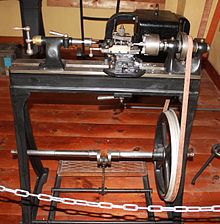
The lathe is driven by a foot rocker, chain and flat belt

A lathe around 1889, on the left the headstock with various pulleys, on the right the tailstock, in the middle the tool slide (support)
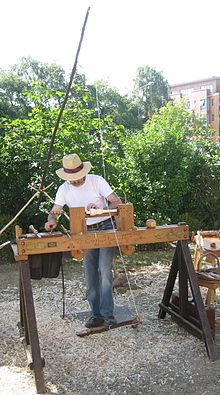
A foot rocker and a cord are used to set the rotating part in rotation on the rocker lathe.
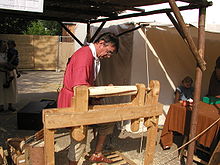
Replica of an old-fashioned rocker lathe
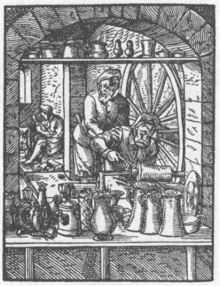
A pitcher maker turns utensils made of pewter while his assistant operates the large drive wheel. Illustration from the Ständebuch by Jost Ammann from 1568
General structure
The lathe has been adapted to many special applications throughout its history. Today, a wide range of different models is available, but they are similar in their basic design. The work spindle (rotary axis) is usually arranged horizontally for small diameters of the workpiece, and more vertically for large diameters. The main components are the frame and the machine bed to which the other parts are attached, the headstock which contains the work spindle, the main drive for the spindle and the tool slide. In addition, there are some auxiliary devices.
Frame
The frame is either a welded steel construction or made of cast iron, rarely also as a composite construction with polymer concrete. The frame carries the weight of all components, absorbs the forces from the machining process and must therefore be designed to be strong and torsion-resistant. In addition, it must have good damping properties in order to reliably reduce vibrations within the machine. The frame and the machine bed listed below form a unit in regular sizes; only very small table lathes and watchmaker's lathes have a separation of the units "bed" (directly for the machining process) and frame (for raising the machine to a comfortable working height).
Lathe bed
The horizontal machine bed rests on the frame at both ends and supports the tool slide, tailstock and steady rest. Since the cutting edge is constantly engaged on lathes, machine parts are excited to vibrate. This reduces surface finish and dimensional accuracy and increases tool wear, which is why the bed is cast from vibration-damping cast iron with lamellar graphite or reactive resin concrete and the cavities are filled with sand or resin-bonded granite (polymer concrete). On small machines, the bed and frame are one piece, and all of the above parts share two guides. On larger machines, the tool slide travels on two separate guides. To improve work performance, the entire bed is often also inclined (inclined bed) for better chip evacuation or is located above the main spindle. Since the axis of rotation is vertical on vertical lathes, the slide guides are not referred to as a bed, but as a machine column. On front turning machines for flat rotating parts, on the other hand, the bed is perpendicular to the axis of rotation of the work spindle.
Headstock
The headstock is located on the left side of almost every machine. The work spindle, which is often designed as a hollow shaft, is guided there in strong, preloaded and adjustable precision antifriction bearings, as this has little effect on the dimensional stability and enables the chuck to be supplied with bar stock. The work spindle is coupled to the motor via belt drive and gearbox. CNC lathes and also manually operated machines with infinitely variable motor often have only a two- to four-stage gear. This ensures a constant cutting speed even within the speed control range for variable turning diameters, such as for facing. On older models of manually operated machines, the gearbox has 24 to 52 steps, which are changed over with two or three levers. In addition, on some machines it includes a reversing gear to reverse the direction of spindle rotation. However, it is common to change the direction of rotation directly on the motor. Motorized spindles are also used on numerically controlled multi-spindle automatic lathes. The spindle with workpiece holder is built directly into the motor, which saves installation space.
The torque transmission from the main spindle to the workpiece takes place via various clamping devices, such as chucks, collets, face plates and others.
Feed
Manually operated universal lathes still have a feed gearbox that derives power from the work spindle and transmits it to the lead and feed spindles via change gears and feed gears. This allows, for example, the pitches for thread turning to be set by means of respective gear combinations. Numerically controlled machines, on the other hand, have a separate drive for each machining axis. Backlash-free ball screws transmit the motion to the slides, whereby feed rates of up to 60 m/min and accelerations of up to 8 m/s² are possible, but are usually and especially during machining considerably lower. Linear drives, which have become increasingly widespread in recent years, are also suitable for the highest accelerations and travel speeds. Axes in the longitudinal and transverse directions (Z and X axes) are assigned to the tool slide. The traverse path is either read from scale rings on the handwheels or recorded and displayed electronically with displacement measuring systems.
For high feed rates and cutting speeds, special materials are used in machining technology, such as free-cutting steels. These are characterised by low machining forces, good achievable surface qualities and short breaking chips that cannot get caught in the machines.
Tool slide
The tool slide, usually designed as a cross-support, moves longitudinally on the bed, on which the cross slide moves transversely to the axis of rotation. The tool carrier on the top of the top slide of the manually operated center lathe is a tool holder (often designed as a quick-change holder for economical tool changes), and on CNC lathes it is often a tool turret for holding several tools. Various guidance systems are available, whereby better damping guidance systems increase the surface quality and dimensional accuracy.
Nowadays, CNC lathes can also be equipped with driven tools on all tool positions of the turret or on a part of it (often then on every second position), which are mechanically driven in order to drill or mill with them. This is very often accompanied by a so-called spindle orientation, where the turning spindle can be positioned to any exact angular value and then stopped. The turning spindle is then addressed by the control as its own CNC axis and requires its own spindle encoder. This makes it possible to execute complex geometric motion sequences under NC control together with one or more other axes (multi-axis interpolation). By using driven tools, the subsequent finishing on drilling machines and milling machines can be omitted, which is referred to as complete machining.
Tailstock and steady rest
The tailstock is used to support long turned parts by means of a centering point that engages in the centering hole made in the face of the workpiece. Conventional machines have a quill in the tailstock with Morse taper mounting for drill chucks or large drills, which can be turned out parallel to the bed with a handwheel, for producing centric bores.
The steady rest can be used to support long, thin turned parts at any point. It prevents oscillation and deflection of the workpiece due to its own weight and the machining forces. The turned part is supported by means of plain or roller bearings at sufficiently wide points. Optionally or additionally, a cutting force compensator can also be used.
Front turning machines and vertical lathes usually have neither tailstock nor steady rest due to their design.
Workspace determination
With the dimensions of the components given above, it is first possible to make some characteristic statements about possible dimensions of workpieces that can be machined on the lathe.
A distinction is made between the following terms, which must be taken into account when purchasing a lathe:
- Turning length between the tips, alternative specification: tip width
- Swing diameter above the bed, alternative specification: centre height
- Swing diameter over the bed slide
The "turning length between centers" is often measured by disassembling the lathe chuck and mounting a short face driver in the hollow work spindle, from which the sharp-edged driver tips protrude only slightly. On the right side of the lathe an unbored short rigid point is placed in the tailstock to allow the maximum turning length. In most cases, however, this equipment is not optimally suited for the turning purpose, so that the real usable turning length decreases.
The "center height" indicates the radial distance from the tailstock center to the nearest guideway of the machine bed, running perpendicular to one edge of the bed, but usually not vertical; doubling this measurement gives the swing diameter.
However, the swing diameter over the bed is by no means the same as the maximum workpiece diameter, since a workpiece usually still has to be clamped externally by jaws on the chuck, and these jaws also have to swing over the bed. Only in the case of workpieces that can be clamped at the face or internally can the workpiece diameter be slightly smaller than the circulating diameter above the bed. In practice, it is often a matter of a few millimetres whether a workpiece can be machined on a particular machine or not. The swing diameter over the bed does not include the tool slide: it must remain to the right of the workpiece and, since the slide cannot move underneath, machining must either be carried out on the face side or on the circumferential side with long projecting and therefore unstable tool holders.
The swing diameter over the bed slide is often considerably smaller than the diameter over the machine bed. On the vast majority of lathes, stable external machining is only possible if the slide moves under the turned part - and thus the workpiece diameter is limited to that "over bed slide". Since, in turn, the slide often does not remain "naked", but also varies in dimensions with clamping tools of different heights, turrets or the like, only a consideration as a whole counts. In addition, care must be taken to ensure that the measuring equipment that may be used can also be used. The question regarding the sufficient working space of a machine is: Can the given workpiece with its raw dimensions (or preliminary dimensions) be clamped stably with the available clamping devices in such a way that with sufficiently stable tools (together with their clamping devices) all the turning surfaces specified in the drawing of the workpiece to be machined can be reached in order to carry out (not only an extremely tightly possible, but also) an economical machining operation?
As a rule, this question cannot be answered with simple statements such as "peak height 400 times peak width 1200".

Drum turret head of a CNC universal lathe

Lathe on Chinese Renminbi Banknote
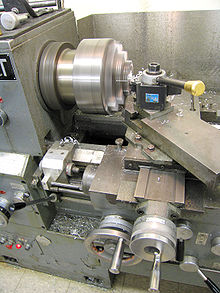
Turning of an aluminium bottle opener on a universal lathe
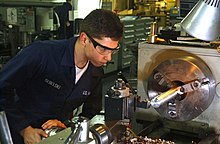
lathe operator
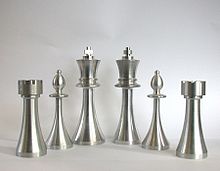
Chessmen turned with a CNC lathe. (The cross on the king and the battlements on the rooks cannot be made by turning, but require additional milling).
Questions and Answers
Q: What is a lathe?
A: A lathe is a type of machine used to shape things, by turning an object on an axis and applying a tool to shape it.
Q: What are some types of work that use lathes?
A: Various kinds of work such as woodturning, metalworking, metal spinning, spin welding, and glassworking use lathes.
Q: What axis does most lathes turn the workpiece on?
A: Most lathes turn the workpiece on a horizontal axis; the potter's wheel uses a vertical axis.
Q: What are the various types of lathe machines?
A: There are various types of lathe machine, but horizontal lathes are used widely.
Q: What are CNC lathes?
A: CNC (Computer numerical control) lathes can perform the same jobs more accurately than manual lathes.
Q: How does a lathe work?
A: Lathes work by using accessories such as cutting tools and rests to shape the workpiece.
Q: What are some examples of objects that can be made using a lathe?
A: Examples of objects that can be made using a lathe are candlestick holders, gun barrels, cue sticks, and baseball bats.
Search within the encyclopedia